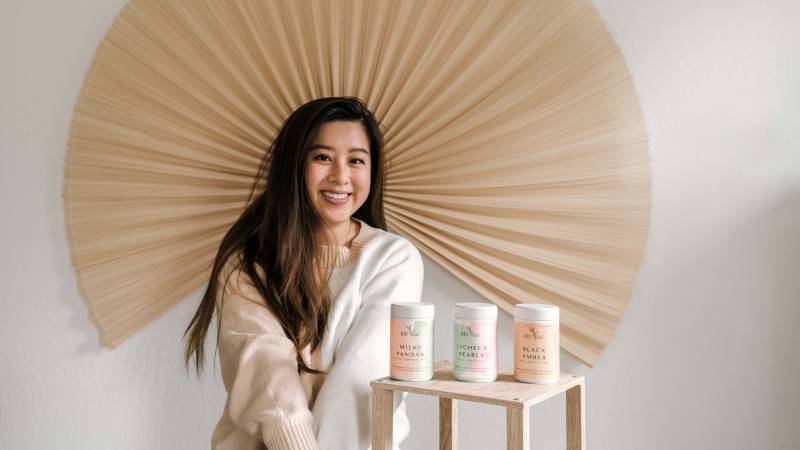V
iolet Diana Nguyen has a vivid memory of dismounting from a moped onto the dirt road that led to her auntie’s house in Vietnam, where she sat down to a sumptuous spread of dragon fruit, longan and lychee while her relatives badgered her about her romantic life.
How do you translate a memory like that into a flavor or an aroma? That’s the type of question Nguyen attempts to answer when she creates tea blends for her new business, Kin Leaf Tea. Frequently sold out since it launched in November 2021, the South Bay company offers blended loose leaf teas rooted in Nguyen’s Vietnamese American upbringing—her memories of pandan waffles and sugarcane juice from San Jose’s food courts and meals shared with family during childhood visits to Vietnam.
The company’s story begins at a place that has become a crucial marker of identity for many of the Bay Area’s Asian Americans: a boba shop. While working as a boba barista on the Peninsula in her early 20s, Nguyen found that the food service industry’s rapid pace, combined with an unlimited access to caffeine, caused her to develop an unhealthy relationship with tea. She would leave work with jitters. At home, Nguyen started to treat the process of brewing hot tea as a ritual, carefully watching the water turn golden. She found that slowly sipping a cup of tea with friends and family inspired thoughtful conversations too. “It really forced me to slow down, make smaller batches and brew them for one or two people,” Nguyen says. “In that moment of brewing, you have to be present.”
Nguyen remains an avid boba drinker, but she sees her new company as a retort to a fast-paced Silicon Valley fueled by caramelized tapioca pearls and 32-ounce cups of syrup-laden beverages. With Kin Leaf Tea, she wanted to combine the creative flavors found at boba shops with a more mindful approach, so she started exploring tea blends—mixtures of teas that may include flavorings like flowers, herbs and fruits. Typically, Nguyen says, these blends tend to use cheap filler ingredients and low-quality tea leaves that produce watery drinks. For example, lychee-flavored teas are often paired with overpowering amounts of rose: “It drove me nuts because I don’t want to drink potpourri on a daily basis.”

So, Nguyen set about the task of creating new tea blends using high-quality ingredients. For inspiration, she turned to her Vietnamese American childhood. After all, her aromatic school lunches and the family pictures she took amongst durian trees all served as a marker of difference for her when she was growing up.


